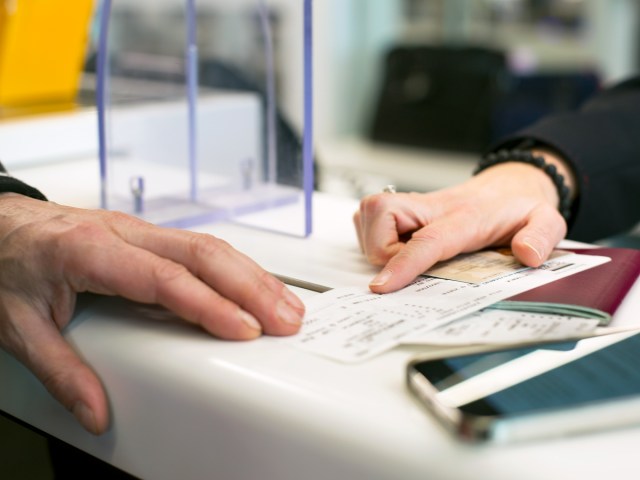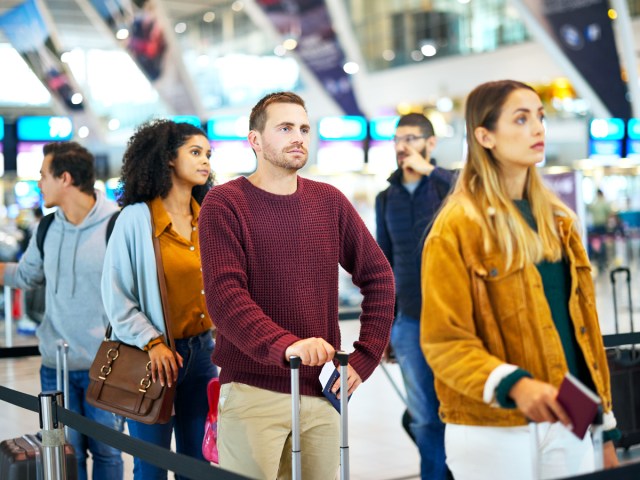When they’re available, direct routes are usually preferable for air travel. However, nonstop fares can be far more expensive, and sometimes airline schedules dictate that a layover is unavoidable. But if any disruptions arise on the day of travel, you may find yourself facing the prospect of missing a connecting flight — perhaps through no fault of your own. If that happens, it’s helpful to know your rights and responsibilities ahead of time. Here’s what you should — and shouldn’t — do when you miss a connecting flight (and how to avoid the chance of doing so in the first place).
Always Book a Through Ticket

The first thing you should do to make life easier in case you miss a connecting flight requires some advance planning. Before you even get to your travel day, start by always booking a through ticket. This means that your entire journey, even if it involves multiple connecting flights or airlines, falls under a single itinerary. That way, if the inbound leg is canceled or delayed, forcing you to miss your next flight, it will typically be the airline’s responsibility to ensure you make it to your final destination.
Conversely, if you choose to book separate tickets (as can often be the case if you book with low-cost carriers) and the first part of your journey doesn’t go according to plan, you’ll usually be on the hook for a costly last-minute replacement ticket for the next leg. The second airline has no obligation to rebook you, so to avoid potential headaches, book a through ticket or, if that’s not possible, leave plenty of time for your layover.
Know Your Rights

A missed connection can result in a lot of unexpected costs, including overnight accommodation, meals, and onward transportation. Your rights will vary depending on the circumstances.
While an airline will always rebook you on the next available flight, there’s an important distinction depending on whether your delay or cancellation was deemed controllable or related to factors outside the airline’s control. Airline-caused delays can include maintenance or crew problems, cabin cleaning, baggage loading, and fueling. On the other hand, noncontrollable delays often have to do with weather or air traffic control constraints, for example.
Each airline sets its own policy in the event of controllable delays or cancellations. The Department of Transportation has a helpful dashboard that outlines those commitments.
You’ll note, for example, that all major U.S. airlines offer to rebook the passenger on the same airline at no additional cost, but only some will rebook you on a partner airline. And while most airlines offer a complimentary hotel stay in the event of a cancellation that results in an overnight layover, one airline, Frontier, does not. But all airlines will offer meal vouchers if the delay or cancellation results in a passenger waiting three or more hours. If your disruption is three or more hours, you may also be entitled to a full refund, thanks to new DOT rules that went into effect in late 2024.
Be Proactive as You Wait in Line

If your inbound flight is delayed and you know you’ll miss the next leg, you’ll need to find an alternative as soon as possible. And if a significant number of passengers are affected, spaces on upcoming flights are likely to be very limited, so the sooner you’re able to rebook, the more options you’re going to have.
An airline representative may be waiting at the gate to help rebook passengers; if not, look for a customer service desk in the terminal. But while you wait in line or before you even get there, see if you can rebook via the airline’s website or app — often the easiest way — or call the airline’s customer service desk. With a bit of luck, you’ll have already rescheduled your connecting flight before you reach the front of the queue. And if not, keep your tone friendly and don’t lose your cool; taking your frustration out on an airline employee isn’t going to get you anywhere.
Sometimes You’re on Your Own

What if the new flight you’re offered doesn’t cut it? If you don’t accept the alternative arrangements that you’re being offered, or none are available, the airline is permitted to refund the unused ticket and leave you to fend for yourself. In this situation, it pays to have a travel insurance policy that covers you for delayed or missed flights and the unexpected costs that come with it.
It’s also a smart idea to have done a little homework — just in case — so that you already have a tentative Plan B in mind. Whether this is ground transportation, an alternate airport, or a change of airline, being ready to make backup arrangements puts you ahead of the pack. In short, it pays to be proactive.
Allow Enough Time at the Airport

Few travelers love hanging around at the airport — we’d rather spend that time enjoying our vacation or getting home a little earlier. However, trimming the gap too much between a pair of flights isn’t wise. Airlines set what they call minimum connecting times (MCTs), but even sticking to this is no guarantee. The MCT between U.S. domestic flights can be as little as 30 to 40 minutes; for international connections, it can be one hour.
Realistically, the time you should allow between flights depends on a range of factors. These include whether the connecting airport is large or small, the size of the plane for your first flight (because of the time it takes to disembark), whether your connecting flight departs from a different terminal, and whether you need to recheck bags, clear security, or pass through immigration. To reduce the likelihood of missing your connecting flight in the first place, build in some leeway comfortably above the MCT — after all, you can always relax over a coffee or pass the time browsing the goods for sale in the airport’s shops.
More from our network
Daily Passport is part of Inbox Studio, which publishes content that uplifts, informs, and inspires.

















